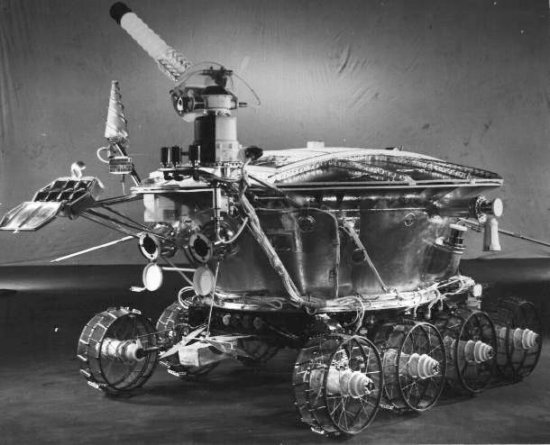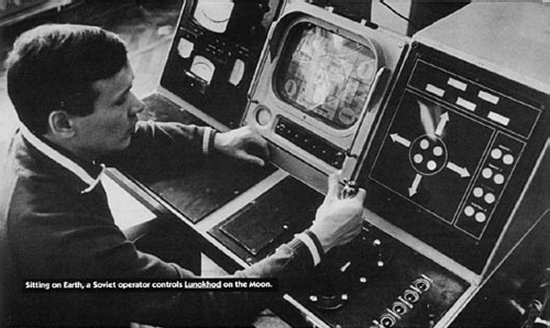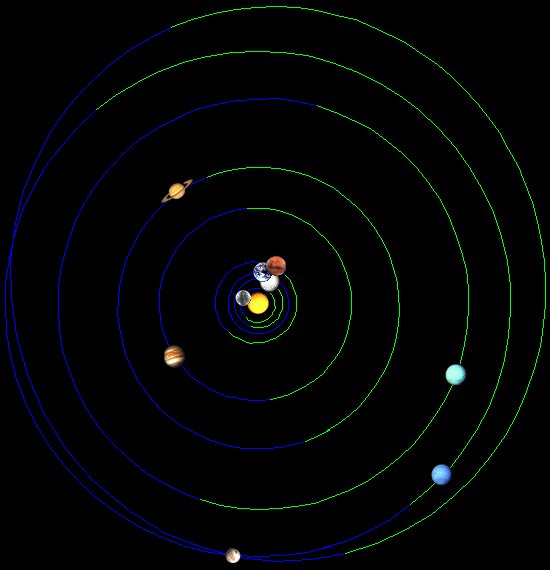|
||||||||||
|
|
||||||||||
|
||||||||||
|
|
||||||||||
Given a known distance, we can rearrange this relationship to solve for the time it takes to travel that distance at a certain speed.
The average distance between the Earth and Moon is about 239,000 miles (384,600 km). Plugging this value and the speed of light into the above equation allows us to solve for the time it takes for radio waves to travel between the Moon and Earth, as shown below.

In other words, it takes only about one and a quarter seconds for radio signals to travel between astronauts on the Moon and ground controllers on Earth. This lag is pretty minimal and made communications between the astronauts and Earth nearly real time.

Since the round trip for sending and receiving a signal is only about 2.5 seconds, Earth-based controllers have also been able to maintain near real-time control over unmanned vehicles sent to our neighbor in space. The Soviets were first to do so after successfully landing the Lunokhod 1 unmanned rover on the lunar surface in 1970. Although the experience demonstrated that good on-board vision and hazard sensing, operator skill, and patience were required to overcome the time lag, the vehicle's slow responsiveness made it practical to control the rover remotely from Earth.
Nevertheless, this fact did not stop a rather comical urban legend of the time in which some Russians were led to believe that the Lunokhod rover was actually under the control of a midget-sized crewman sent along for the ride. The plucky adventurer was said to be a dwarf specially trained for the flight by the infamous KGB. As the rover mission was a one-way trip, the pint-sized hero bravely gave his life to advance science and national pride. The fact that sufficient supplies could have never been packaged into the tiny rover to sustain a human's life during the 11-month long mission was just one practical issue neglected by the bizarre rumor.

The same "real time" control cannot be achieved aboard the rovers sent to Mars, however. Being much farther from Earth, it takes considerably longer for communications signals to travel the great distances between the two planets. Even at their closest approach when both planets are on the same side of the Sun, the two worlds are separated by about 35 million miles (55.7 million km). A radio wave traveling at the speed of light takes over three minutes to cover this distance. When on opposite sides of the Sun, the distance between Earth and Mars grows considerably larger and reaches a maximum of almost 250 million miles (401 million km). The one-way communication time then increases seven-fold to over 22 minutes! It was because of this long communication lag that NASA's Mars rovers were given much more sophisticated autonomous control to drive themselves independent of a controller millions of miles away on Earth.
We can calculate the length of time it takes for a radio signal, light, or any other electromagnetic wave to travel between two objects using the basic definition of speed described earlier. The only information needed is the distance between the two points. The following table was generated using data from astronomy sites like Solar System Live. This site calculates the position of each of the planets at any given time and provides its location in the sky and distance from Earth.

I chose to calculate the relative locations of the planets at 5 PM on 11 December 2005 at the very time I was
completing this article. The following table lists the time it would take for a radio signal from Earth to reach
each of the major bodies within the solar system at that instant. Also included are a few noteworthy objects
outside our solar system. Distances are provided in miles and kilometers as well as Earth Radii (ER), Astronomical
Units (AU), and light years (ly) where appropriate. Earth Radii is a measurement of distance based on the
equatorial radius of the Earth (1
| Distance from Earth & One-Way Communication Time at 5 PM on 11 December 2005 |
||||
|---|---|---|---|---|
| Object | Distance* [miles] | Distance* [km] | Distance* | Time |
| Moon | 233 thousand | 375 thousand | 58.8 ER | 1.25 seconds |
| Venus | 36.4 million | 58.6 million | 0.392 AU | 3.26 minutes |
| Mars | 57.5 million | 92.6 million | 0.619 AU | 5.15 minutes |
| Sun | 91.6 million | 147.4 million | 0.985 AU | 8.19 minutes |
| Mercury | 92.4 million | 149 million | 0.994 AU | 8.27 minutes |
| Jupiter | 572 million | 921 million | 6.159 AU | 51.22 minutes |
| Saturn | 786 million | 1.26 billion | 8.454 AU | 1.17 hours |
| Uranus | 1.88 billion | 3.03 billion | 20.266 AU | 2.81 hours |
| Neptune | 2.84 billion | 4.58 billion | 30.603 AU | 4.24 hours |
| Pluto | 2.98 billion | 4.79 billion | 32.017 AU | 4.44 hours |
| Proxima Centauri (closest star to Sun) |
24 trillion | 40 trillion | 4.2 ly | 4.2 years |
| Sirius (brightest star in night sky) |
51 trillion | 82 trillion | 8.7 ly | 8.7 years |
| Aldebaran (brightest star in Taurus) |
353 trillion | 568 trillion | 60 ly | 60 years |
| Regulus (brightest star in Leo) |
406 trillion | 653 trillion | 69 ly | 69 years |
| Spica (brightest star in Virgo) |
1.3 quadrillion | 2.1 quadrillion | 220 ly | 220 years |
| Rigel (brightest star in Orion) |
8.2 quadrillion | 13 quadrillion | 1400 ly | 1400 years |
| Andromeda (closest galaxy to Milky Way) |
17 quintillion | 27 quintillion | 2.9 million ly | 2.9 million years |
| * Your mileage may vary | ||||
Also note that these times indicate the length of time it takes for light from those objects to reach the Earth.
When we look at the Moon at night, we are actually seeing it as it appeared one second earlier. The light waves
emitted by the Sun to illuminate and warm the Earth left the solar surface about eight minutes before reaching our
planet. The star light we see in the night sky can take many millennia to reach Earth. For example, the light we
are seeing today from the Andromeda galaxy, our closest neighboring galaxy, was emitted almost three million years
ago when the earliest species of humans were just evolving here on Earth.
- answer by Molly Swanson, 11 December 2005
Related Topics:
Read More Articles:


|
Aircraft | Design | Ask Us | Shop | Search |

|
|
| About Us | Contact Us | Copyright © 1997-2023 | |||
|
|
|||